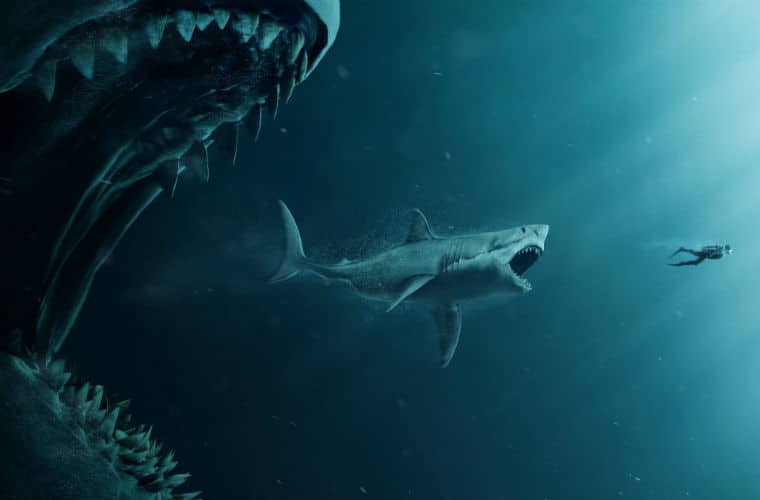The Jason Statham giant shark movie promises ridiculous fun, but like all good science fiction, it was inspired by the real world.
Around 23 million years ago, the most fearsome shark in history roamed the seas, feeding on whales and other large ocean mammals. Known as the Carcharocles Megalodon, the creature is widely considered the most formidable predator in the history of formidable predators due to its enormous size. But just how big was this bad boy?
As Megalodon research has largely been based on the discovery of fossilized teeth, the exact size of the mega shark is uncertain and has been a contentious source of debate among experts. You see, when sharks die they sink to the bottom of the ocean and their bones dissolve because they’re made up of cartilage. For the most part, only the teeth are left behind. So without any significant skeletal remains to go by, you can see why proving the breadth and width of a prehistoric sea creature hasn’t been easy. Estimates by paleontologists have ranged from 40 to 100 feet. However, general consensus believes that Megalodon was around 55 to 60 feet long from head to tail and weighed up to 100 tonnes. Needless to say, it’d take a rather sizeable fish tank to store one of these toothy sea titans.
It is generally believed that the creature went extinct 1.6 million years ago. But depending on who you ask, there’s reason to believe that the Megalodon existed as recently as 10,000 years ago. More interestingly, though, others believe that the prehistoric shark could still be out there. For the sake of wonder and excitement, let’s entertain the idea that Meg is still out there.
Tales of giant sharks exist throughout history, and while many of them have been hoaxes, there have been enough reported sightings to suggest that maybe this notion isn’t completely nonsensical.
In 1918, fishermen in deep water near the Broughton Islands, New South Wales, Australia, claimed that a giant ghostly shark made off with their crayfish pots and nets. They believed that the beast was over 100 feet tall and dubbed it “Lord of the Deep.” Another account from 1933 told of a monstrous shark that was spotted by a father and son aboard the S.S. Manganui ship in Rangiroa, French Polynesia. In the case of the latter, expert Ben S. Roesch believes that the creature they saw was a whale shark.
Recently, a video from 2016 showed footage of a shark believed to be 50 feet in length. Naturally, many believed that the Meg was back in action. Unfortunately, it was later revealed that the creature was merely a sleeper shark and nowhere near as big as originally claimed. Way to get our hopes up and spoil them. Pfft.
The Megalodon probably doesn’t exist these days. But the discovery of other other prehistoric fish long presumed extinct has propelled the belief that — just maybe — anything is possible. For example, Coelacanths are an extremely old and rare species of fish that live at great depths of the ocean and mostly stick to caves. They were also believed to have been extinct for 65 million years until they were found swimming around off the coast of South Africa in 1938. Since then many have been spotted throughout the world.
It’s also not uncommon for large sharks to make themselves undetectable. Take the Megamouth shark, for example. Despite being up to 15 feet in length at their largest, they weren’t discovered until 1976. While this isn’t evidence that the Meg still exists by any means, the Megamouth shark is living proof that giant creatures do exist in the depths of the ocean where humans can’t find them.
These mysteries of the deep were what inspired author Steve Alten when he came up with the idea for his shark novel in the first place, though. With scientific discoveries unveiling new secrets of the ocean all the time, it would be silly to completely rule anything out. In a recent interview with Film Goblin, he discussed the facts that inspired his fiction:
“I was reading a TIME mag article on the Mariana Trench and hydrothermal vents and an idea hit me — what if that giant shark was still alive, living in the abyss? So I spent a month doing research and making sure it had not been done before, then began writing at the only free time I had available – 10 pm until 3 am and weekends.”
The Mariana Trench, located in the Pacific Ocean, has a known depth of 10,994 meters. To this day scientists are still trying to discover what really lies at the bottom of it. That said, the world’s oceans are just as mysterious as the galaxy. An article published by the National Ocean Service revealed that more than 80 percent of the Earth’s seas remain unmapped or unexplored. Who knows what fascinating secrets lurk beneath their waves?
In a reissued version of “Meg: A Novel of Deep Terror“, Alten highlighted how some of his theories about the mysteries of the ocean came to light. Several months after the book was published, scientists discovered a warm ceiling of plume hovering over a vent in the Atlantic Ocean. Following that, a new breed of shark was discovered in the Sea of Japan that was 24 feet long. Here we are 20 years later and scientists are still discovering new wonders about our planet. It remains to be seen whether the Megalodon truly is extinct, but who’s to say that a creature even more fearsome and formidable isn’t reigning supreme in some undiscovered ocean somewhere?

